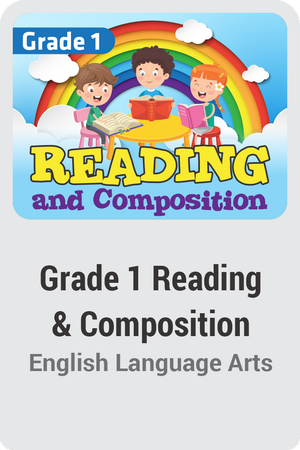
Course Overview:
In 1st Grade Reading and Composition, students will explore the patterns of literary and informational texts. The course begins by providing explicit instructions for academic vocabulary and comprehension skills. Then, each Unit guides students through the process of close reading. Students will read a variety of literature, including fun and classic pieces such as “Twinkle, Twinkle, Little Star” and “Goldilocks and the Three Bears.” Students will practice using reading strategies to understand the literal meaning and purpose of a text. Students will also learn how to use evidence to make predictions and inferences about texts. At the end of each Unit, students will apply their learning of texts by composing their own texts.
Prerequisites:
Kindergarten (Recommended)
Required Materials:
- paper
- paper or notebook *for journal entries
- pencils
- scissors
- glue
- stapler
- video recording device
- 1 brad
- 1 pack colored pencils, markers, or crayons *specific colors required below
- 1 pack construction paper
- poster(optional)
Syllabus:
Unit 1: Patterns
- What are texts?
- What are Predictions?
- What are inferences?
- What is a story?
- What is an informational text?
- What is a persuasive text?
- What is a poem?
- What are the parts of a book?
- What is a digital text?
Unit 2: Poems
- How do poets make patterns?
- How do poets make descriptions?
- Does “To the Bat” have patterns?
- How do poets tell stories?
- What are nursery rhymes?
- How do nursery rhymes teach kids?
- Can poems have information?
- Can nursery rhymes have information?
- What are acrostics?
Unit 3: "Goldilocks and the Three Bears"
- What are the details?
- What are reading strategies?
- What are folktales?
- What happened first?
- What happened next?
- What are antonyms?
- What are synonyms?
- What are the themes?
Unit 4: Pinocchio
- What is Pinocchio?
- Is Pinocchio magical?
- Is Pinocchio good?
- What are the details?
- Where is Pinocchio?
- Does Pinocchio change?
- What happened to the fairy?
- Do they live happily ever after?
- What is the theme?
Unit 5: Fables
- What are fables?
- How should we treat others?
- Can wisdom beat strength?
- What barks but does not bite?
- What is easier said than done?
- What is drama?
- Can little things make a difference?
- Is the crow wise?
- How do we compare and contrast?
Unit 6: Text about Kites
- How do we use patterns?
- Which details are important?
- How can we learn more?
- How is information organized?
- What are kite festivals?
- How does a poem describe a kite festival?
- What did the Wright brothers do?
- What did Ted do?
Unit 7: Texts about the Sky
- What files in the sky?
- What is in the sky at bedtime?
- What is the sun?
- How many planets are there?
- How do we read how-to texts?
- What makes the daytime and nighttime?
- What do shadows do?
- What is a moon cake?
- What can digital texts have?
Unit 8: Texts about the Weather
- How do we talk about the weather?
- What kind of weather makes you happy?
- What kind of weather does a snowman need? And Writing Journal: Snowman Prediction
- What are clouds? And Writing Journal: Cloud KWL
- Why should you go camping?
- What are snow tracks? And Writing Journal: Snow Tracks Prediction.
- Which birds come out in the winter?
- Which month is the best?
- What are the signs of summer?
Unit 9: Texts about Plants and Animals
- Who is Wilhelmina Seegmiller?
- Can poems teach art?
- What do you imagine?
- How do reptiles live in the desert?
- How do other animals live in the desert?
- How do cacti live in the desert?
- Who ate the Grimm brothers?
- Where does Rapunzel live?
- How does the story end?
Unit 10: Texts that You Can Read Yourself
- What are quotation marks?
- How do you fix a fence?
- How do you play Mother Goose?
- How do rhyming words help?
- How do you sleep?
- What are shells?
- How do beavers build their houses?
- How can you be careful?


